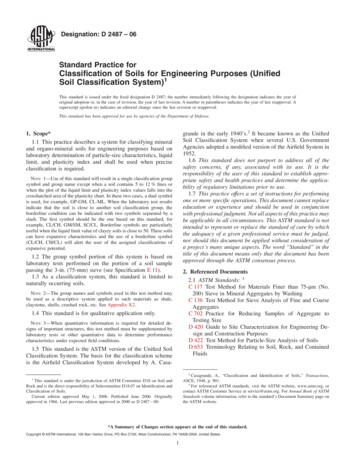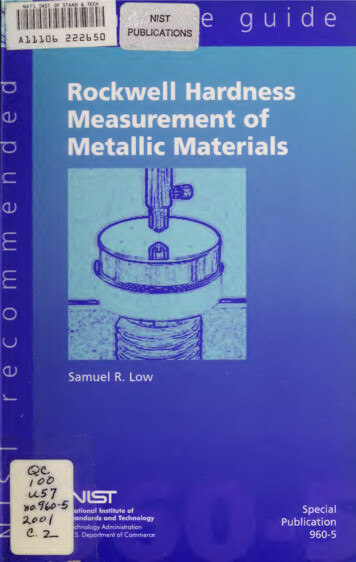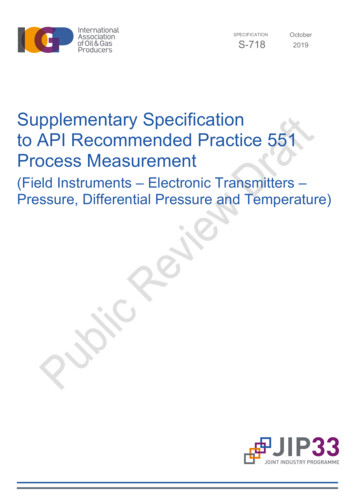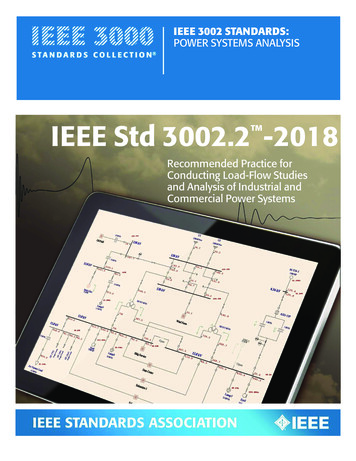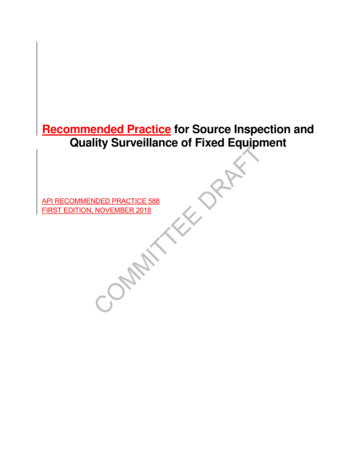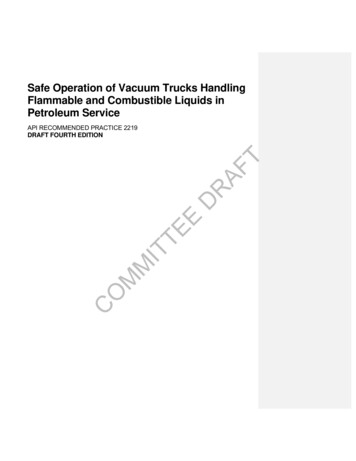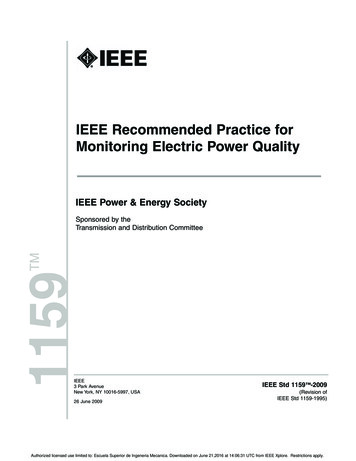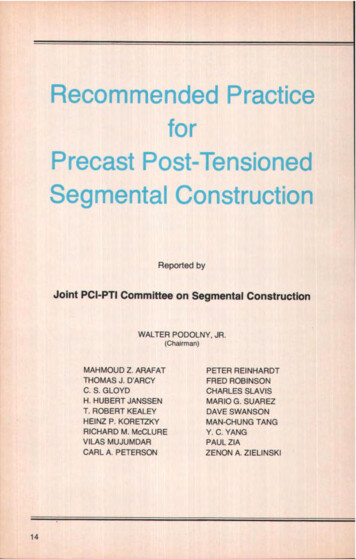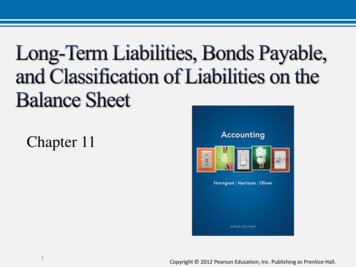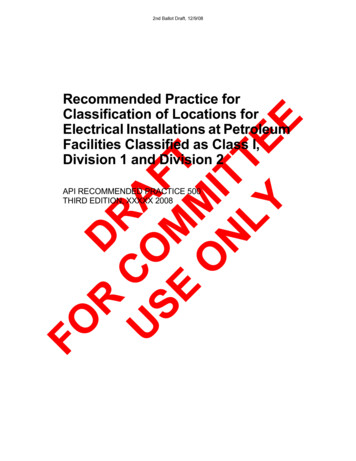
Transcription
2nd Ballot Draft, 12/9/08FOR DRCU O AFSE M TMO IN TTLY EERecommended Practice forClassification of Locations forElectrical Installations at PetroleumFacilities Classified as Class I,Division 1 and Division 2API RECOMMENDED PRACTICE 500THIRD EDITION, XXXXX 2008
FOR DRCU O AFSE M TMO IN TTLY EE2nd Ballot Draft, 12/9/08
2nd Ballot Draft, 12/9/08FOR DRCU O AFSE M TMO IN TTLY EERecommended Practice forClassification of Locations forElectrical Installations at PetroleumFacilities Classified as Class I,Division 1 and Division 2Upstream SegmentAPI RECOMMENDED PRACTICE 500THIRD EDITION, XXXX 2008
2nd Ballot Draft, 12/9/08Special NotesAPI publications necessarily address problems of a general nature. With respect to particular circumstances, local,state, and federal laws and regulations should be reviewed.FOR DRCU O AFSE M TMO IN TTLY EENeither API nor any of API's employees, subcontractors, consultants, committees, or other assignees make anywarranty or representation, either express or implied, with respect to the accuracy, completeness, or usefulness of theinformation contained herein, or assume any liability or responsibility for any use, or the results of such use, of anyinformation or process disclosed in this publication. Neither API nor any of API's employees, subcontractors,consultants, or other assignees represent that use of this publication would not infringe upon privately owned rights.API publications may be used by anyone desiring to do so. Every effort has been made by the Institute to assure theaccuracy and reliability of the data contained in them; however, the Institute makes no representation, warranty, orguarantee in connection with this publication and hereby expressly disclaims any liability or responsibility for loss ordamage resulting from its use or for the violation of any authorities having jurisdiction with which this publication mayconflict.API publications are published to facilitate the broad availability of proven, sound engineering and operatingpractices. These publications are not intended to obviate the need for applying sound engineering judgmentregarding when and where these publications should be utilized. The formulation and publication of API publicationsis not intended in any way to inhibit anyone from using any other practices.Any manufacturer marking equipment or materials in conformance with the marking requirements of an API standardis solely responsible for complying with all the applicable requirements of that standard. API does not represent,warrant, or guarantee that such products do in fact conform to the applicable API standard.All rights reserved. No part of this work may be reproduced, stored in a retrieval system, or transmitted by any means, electronic,mechanical, photocopying, recording, or otherwise, without prior written permission from the publisher. Contact the Publisher, APIPublishing Services, 1220 L Street, N.W., Washington, D.C. 20005.Copyright 2008 American Petroleum Institute
2nd Ballot Draft, 12/9/08ForewordNothing contained in any API publication is to be construed as granting any right, by implication or otherwise, for themanufacture, sale, or use of any method, apparatus, or product covered by letters patent. Neither should anythingcontained in the publication be construed as insuring anyone against liability for infringement of letters patent.FOR DRCU O AFSE M TMO IN TTLY EEThis document was produced under API standardization procedures that ensure appropriate notification andparticipation in the developmental process and is designated as an API standard. Questions concerning theinterpretation of the content of this publication or comments and questions concerning the procedures under whichthis publication was developed should be directed in writing to the Director of Standards, American PetroleumInstitute, 1220 L Street, N.W., Washington, D.C. 20005. Requests for permission to reproduce or translate all or anypart of the material published herein should also be addressed to the director.Generally, API standards are reviewed and revised, reaffirmed, or withdrawn at least every five years. A one-timeextension of up to two years may be added to this review cycle. Status of the publication can be ascertained from theAPI Standards Department, telephone (202) 682-8000. A catalog of API publications and materials is publishedannually by API, 1220 L Street, N.W., Washington, D.C. 20005.Suggested revisions are invited and should be submitted to the Standards Department, API, 1220 L Street, NW,Washington, D.C. 20005, standards@api.org.iii
FOR DRCU O AFSE M TMO IN TTLY EE2nd Ballot Draft, 12/9/08
2nd Ballot Draft, 12/9/08FOR DRCU O AFSE M TMO IN TTLY EETable of Contents will be generated with Final Page Proofs.v
2nd Ballot Draft, 12/9/08IntroductionThis recommended practice is under the joint jurisdiction of the API Exploration and Production (E&P) Department,Committee on Production Equipment Standards, the API Manufacturing Distribution and Marketing (MDM)Department, Committee on Refinery Equipment, and the Pipeline Operations Technical Committee. It is based upona level of knowledge gained through experience and through the successful application of this practice in the refining,drilling and producing, and pipeline segments of the petroleum industry. The first edition of this recommended practicewas issued June 1, 1991 under the joint jurisdiction of the API Production, Refining and Transportation Departments.FOR DRCU O AFSE M TMO IN TTLY EEThe first edition of RP 500A was published in February 1955 as API 500, Recommended Practice for Classification ofAreas for Electrical Installations in Petroleum Refineries. The second edition was published in January 1957. Thethird edition was published as API 500A in April 1966. The third edition was reaffirmed in 1973. The fourth edition waspublished in January 1982 as API 500A, with a new title, Classification of Locations for Electrical Installations inPetroleum Refineries. The fourth edition was reaffirmed in December 1987.API 500B was originally issued January 1961 as API llJ, Recommended Practice for Placement of ElectricalEquipment on Production Leases. The first edition of API 500B was issued in January 1966 under the titleRecommended Practice for Classification in Areas for Electrical Installations at Production Facilities. The title waschanged in the second edition, July 1973, to Recommended Practice for Classification of Areas for ElectricalInstallations at Drilling Rigs and Production Facilities on Land and on Marine Fixed and Mobile Platforms. The thirdedition of API 500B, Recommended Practice for Classification of Locations for Electrical Installations at Drilling Rigsand Production Facilities on Land and on Marine Fixed and Mobile Platforms was issued October 1, 1987.The first edition of API 5OOC was published in September 1966, under the title Recommended Practice forClassification of Areas for Electrical Installations at Petroleum and Gas Pipeline Transportation Facilities, The firstedition was re-approved in 1974. The title was changed in the second edition, July 1984, to Classification of Locationsfor Electrical Installations at Pipeline Transportation Facilities. The second edition was reaffirmed in March 1990.vi
2nd Ballot Draft, 12/9/08Recommended Practice for Classification of Locations for Electrical Installations atPetroleum Facilities Classified as Class I, Division 1 and Division 21 Scope1.1 PurposeFOR DRCU O AFSE M TMO IN TTLY EE1.1.1 The purpose of this recommended practice (RP) is to provide guidelines for classifying locations Class I,Division 1 and Class I, Division 2 at petroleum facilities for the selection and installation of electrical equipment. Basicdefinitions given in the 2008 Edition of NFPA 70, National Electrical Code (NEC), have been followed in developingthis RP. This publication is only a guide and requires the application of sound engineering judgment.NOTERecommendations for determining the degree and extent of locations classified Class I, Zone 0, Zone 1, and Zone 2 areaddressed in API 505, Recommended Practice for Classification of Locations for Electrical Installations at Petroleum FacilitiesClassified as Class I, Zone 0, Zone 1, and Zone 2.1.1.2 Electrical installations in areas where flammable liquids, flammable gases or vapors, or combustible liquidsare produced, processed, stored or otherwise handled can be suitably designed if the locations of potential sources ofrelease and accumulation are clearly defined. Once a location has been classified, requirements for electricalequipment and associated wiring should be determined from applicable publications. Applicable publications mayinclude NFPA 70 or API 14F. Reference Section 2 for publications for other possible applications.1.2 Scope1.2.1 This document applies to the classification of locations for both temporarily and permanently installedelectrical equipment. It is intended to be applied where there may be a risk of ignition due to the presence offlammable gases, flammable liquid-produced vapors, or combustible liquid-produced vapors, mixed with air, undernormal atmospheric conditions (identified throughout this document as “flammable gases and vapors”). Normalatmospheric conditions are defined as conditions that vary above and below reference levels of 101.3 kPa (14.7 psia)and 20 C (68 F) provided that the variations have a negligible effect on the explosion properties of the flammablematerials.The following items are beyond the scope of this document.a) Piping systems used for odorized natural gas used as fuel for cooking, heating, air conditioning, laundry andsimilar appliances.b) Catastrophes such as well blowouts or process vessel ruptures. Such extreme conditions require emergencymeasures at the time of occurrence.c) The suitability of locations for the placement of non-electrical incendiary equipment.d) Classification of locations containing combustible dust, ignitable fibers, or flyings.1.2.2 Recommendations for determining the degree and extent of classified locations for specific examples ofsituations commonly encountered in petroleum facilities are given in Section 8 through Section 14. While it isimportant for area classifications at refineries, production and drilling facilities, and pipeline facilities to agree to someextent, there are differences in production, drilling, transportation and refining facilities. Some differences include theprocess conditions, types and quantities of products handled, the physical size of typical facilities, and varyinghousing and sheltering practices.1.2.3 Section 8 includes applications that are common to several of the facility types described in Section 9 throughSection 14.1
2nd Ballot Draft, 12/9/082API RECOMMENDED PRACTICE 5001.2.4 Section 9 is applicable to locations in which flammable petroleum gases and vapors and volatile flammableliquids are processed, stored, loaded, unloaded, or otherwise handled in petroleum refineries.1.2.5 Section 10 is applicable to locations surrounding oil and gas drilling and workover rigs and production facilitieson land and on marine fixed (bottom-founded, non-floating) platforms where flammable petroleum gas and volatileliquids are produced, processed (e.g. compressed), stored, transferred (e.g. pumped), or otherwise handled prior toentering the transportation facilities.FOR DRCU O AFSE M TMO IN TTLY EE1.2.6 Section 11 is applicable to locations on Mobile Offshore Drilling Units (MODUs).1.2.7 Section 12 is applicable to locations surrounding oil and gas drilling and workover rigs and production facilitieson floating production units (FPUs) such as, but not limited to, tension leg platforms (TLPs), floating productionsystems (FPSs), floating production systems with off-loading (FPSOs), single anchor leg mooring buoys (SALMs),caisson structures, spars, and other floating structures where flammable petroleum gas and volatile liquids areproduced, processed (e.g. compressed), stored, transferred (e.g. pumped) or otherwise handled prior to entering thetransportation facilities.1.2.8 Section 13 is reserved for future use.1.2.9 Section 14 is applicable to onshore and offshore facilities handling the delivery of flammable or combustiblepetroleum liquids or flammable gases. Pipeline facilities may include pump and compressor stations, storagefacilities, manifold areas, valve sites and pipeline right-of-way areas.2 References2.1 Industry Codes, Guides and StandardsVarious organizations have developed numerous codes, guides and standards that have substantial acceptance byindustry and governmental bodies. Codes, guides and standards useful in the classification of locations and in thedesign and installation of electrical systems are listed below. These references are not to be considered a part of thisRP except for those specifically referenced.API Recommended Practice 11S3, Electric Submersible Pump InstallationsAPI Recommended Practice 14C, Recommended Practice for Analysis, Design, Installation and Testing of BasicSurface Safety Systems for Offshore Production PlatformsAPI Recommended Practice 14F, Recommended Practice for Design and Installation of Electrical Systems for Fixedand Floating Offshore Petroleum Facilities for Unclassified and Class I, Division 1 and Division 2 LocationsAPI Recommended Practice 14G, Recommended Practice for Fire Prevention and Control on Open Type OffshoreProduction PlatformsAPI Publication 343, Fugitive Emissions from Equipment Leaks II: Calculation Procedures for Petroleum IndustryFacilitiesAPI Recommended Practice 505, Recommended Practice for Classification of Locations for Electrical Installations atPetroleum Facilities Classified as Class I, Zone 0, Zone 1, and Zone 2API Standard 521/ISO 23251, Guide for Pressure-relieving and Depressuring SystemsAPI Recommended Practice 540, Electrical Installations in Petroleum Processing PlantsAPI Recommended Practice 2216, Ignition Risk
The first edition of RP 500A was publ ished in February 1955 as API 500, Recommended Practice for Classification of Areas for Electrical Installations in Petroleum Refineries. The second edition was published in January 1957. The third edition was published as API 500A in April 1966. The third edition was reaffirmed in 1973. The fourth edition was
